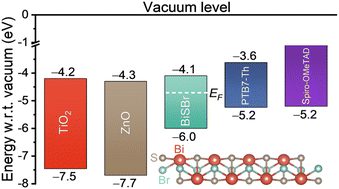J. Mater. Chem. A, 2023, Advance Article
DOI: 10.1039/D3TA04491B, Paper
DOI: 10.1039/D3TA04491B, Paper
 Open Access
Open Access This article is licensed under a Creative Commons Attribution 3.0 Unported Licence.
This article is licensed under a Creative Commons Attribution 3.0 Unported Licence.Xiaoyu Guo, Yi-Teng Huang, Hugh Lohan, Junzhi Ye, Yuanbao Lin, Juhwan Lim, Nicolas Gauriot, Szymon J. Zelewski, Daniel Darvill, Huimin Zhu, Akshay Rao, Iain McCulloch, Robert L. Z. Hoye
Phase-pure thin films of BiSBr are shown to have an optical efficiency limit of 43.6% under indoor lighting, with improved environmental and photo-stability over lead-halide perovskites, and have band positions well suited to a range of charge transport layer materials.
To cite this article before page numbers are assigned, use the DOI form of citation above.
The content of this RSS Feed (c) The Royal Society of Chemistry
Phase-pure thin films of BiSBr are shown to have an optical efficiency limit of 43.6% under indoor lighting, with improved environmental and photo-stability over lead-halide perovskites, and have band positions well suited to a range of charge transport layer materials.
To cite this article before page numbers are assigned, use the DOI form of citation above.
The content of this RSS Feed (c) The Royal Society of Chemistry

